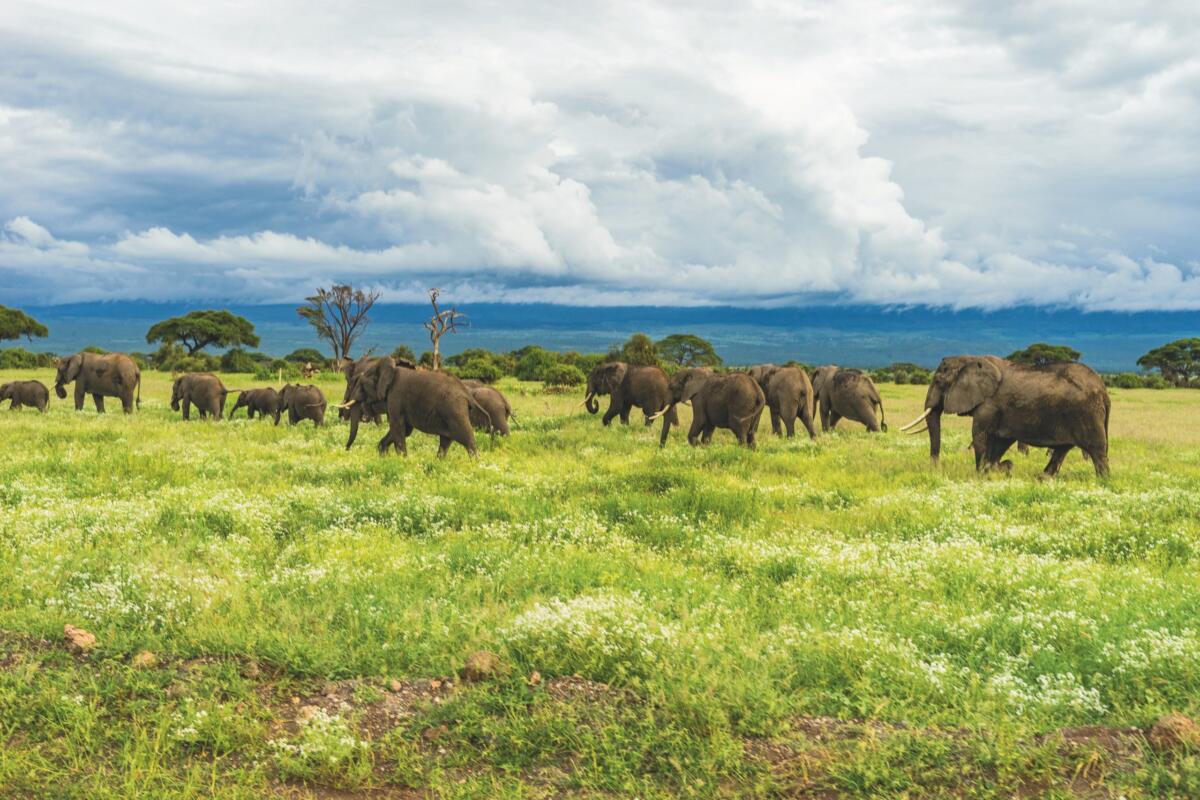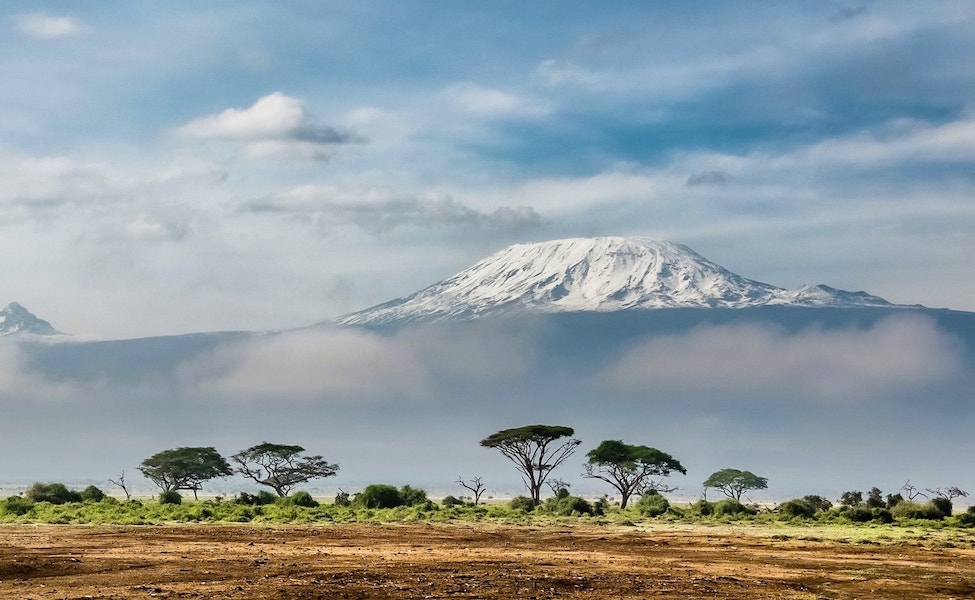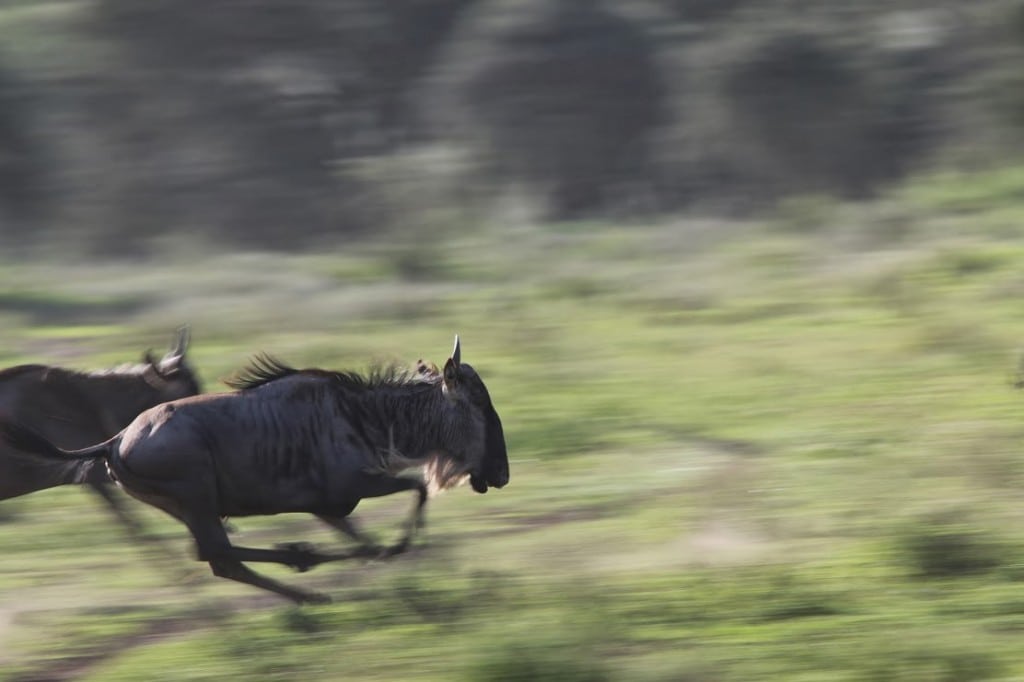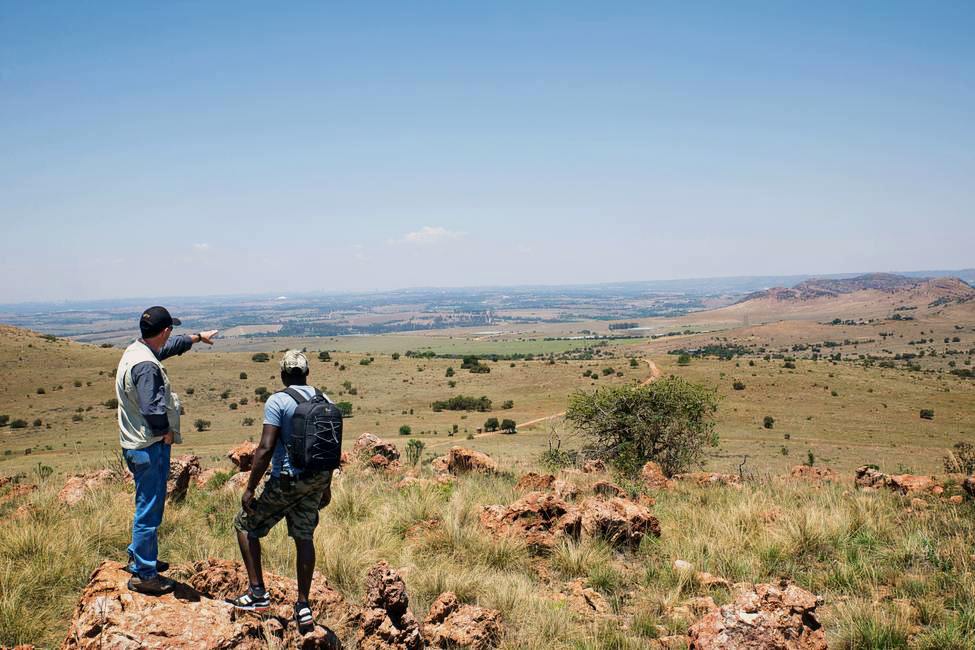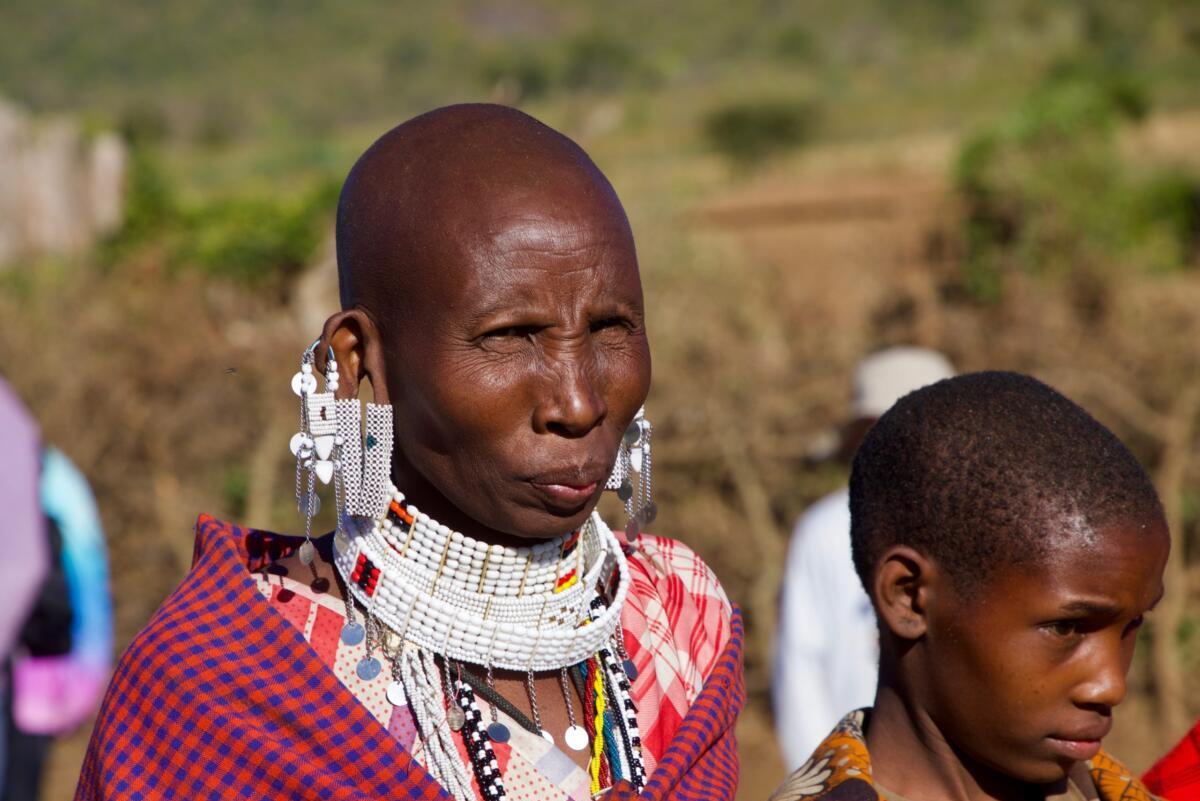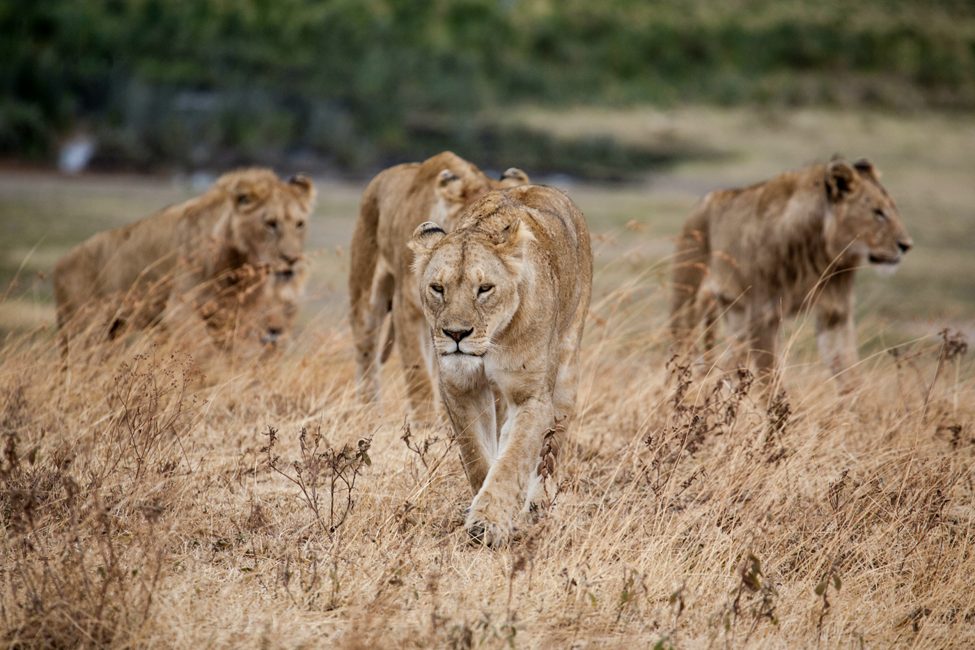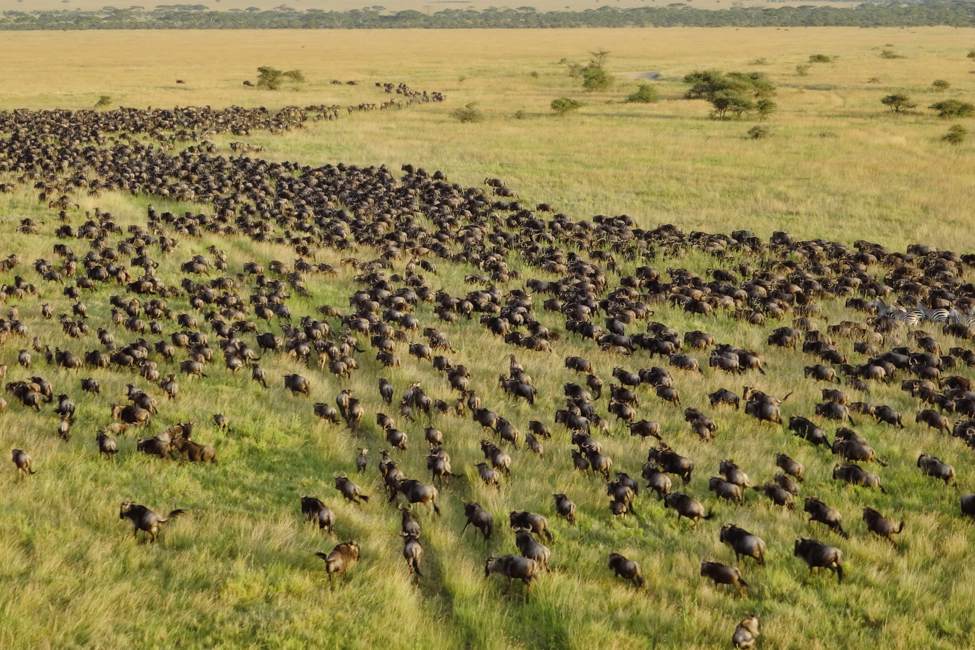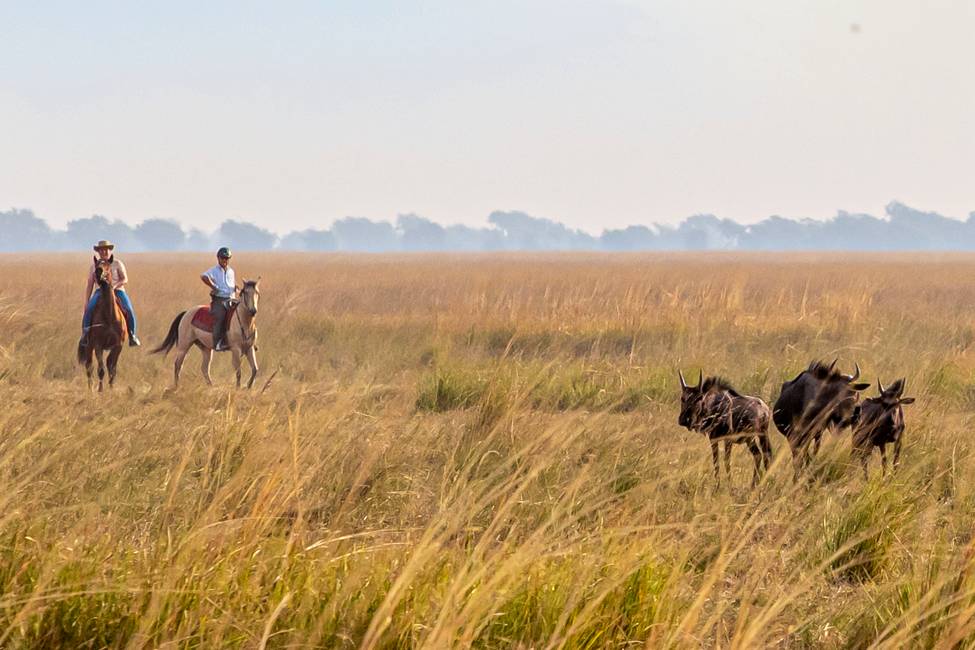Lions prowl in Ngorongoro Crater. Photo by Jeff Lemond.
Top Things to Do in Ngorongoro Conservation Area
In the highlands of Tanzania lies a place where nature’s grandeur unfolds with breathtaking grace—the Ngorongoro Conservation Area. This UNESCO World Heritage Site boasts a unique blend of wildlife, history, and culture that beckons travelers seeking an immersive safari experience. From its expansive plains to its lush forests, this ecological haven teems with adventure.
Spanning around 3,200 square miles of land from Serengeti National Park in the west to Lake Natron region in the east, Ngorongoro Conservation Area gets its name from the breathtaking Ngorongoro Crater at its heart. A special kind of crater known as a caldera, Ngorongoro Crater formed 2.5 million years ago when a Mount Kilimanjaro-sized volcano collapsed. With grasslands and forests on the crater rim to drier savannah and wetlands at the crater bottom, Ngorongoro’s natural amphitheater creates a unique microclimate that supports thousands upon thousands of large mammals.
Ngorongoro Crater is far from the only caldera in the conservation area, which overlaps with a volcanic zone known as the Crater Highlands that includes two other voluminous craters and six peaks that top 10,000 feet.
From leisurely village walks to exhilarating game drives, there is something for every adventurer here. This article outlines just a few of our favorite activities that make Ngorongoro Conservation Area an unforgettable stop on a safari of Tanzania’s northern circuit..
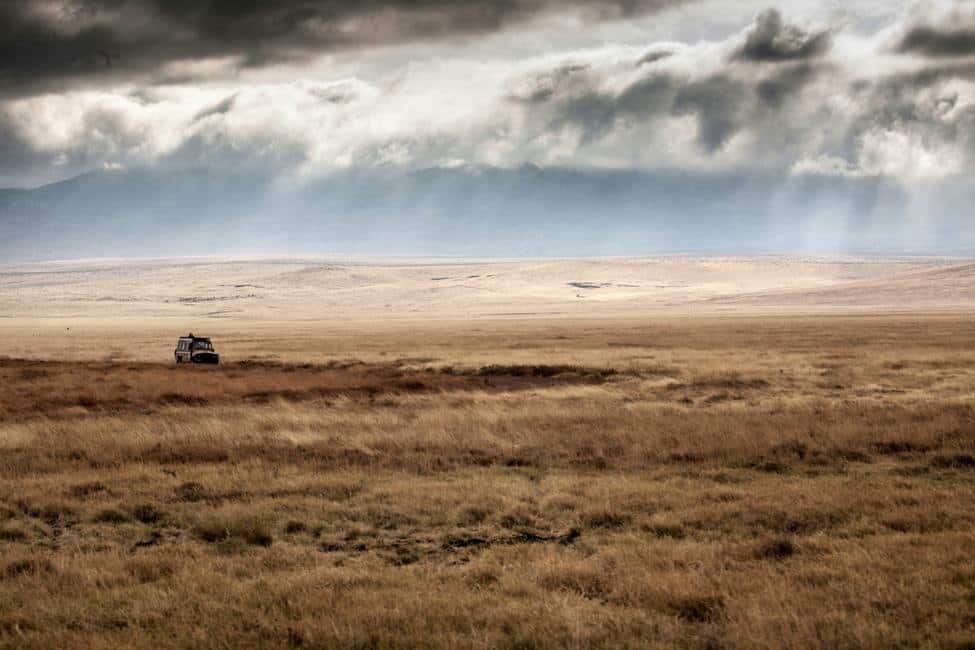
Game drives are an excellent way to explore Ngorongoro Crater. Photo by Jeff Lemond.
Game drives in Ngorongoro
Ngorongoro Crater is one of the most densely populated wildlife areas in Africa—a virtual Noah’s Ark! It is home to all of the Big Five, with lions, elephants, and buffaloes being fairly easy to spot, while rhinos and leopards are more elusive.
Other big mammals abound, as well. Embark on a game drive in the Ngorongoro Crater to stumble upon spotted hyenas, and golden and black-backed jackals as they rest, hunt, or scavenge (depending on their mood). Watch hippos bathing in the marshes fed by the Munge River. Witness wildebeests, zebras, gazelles, and hartebeests grazing the grassland in harmony—the best time of year for this is around February and March, when the Great Wildebeest Migration fills Ngorongoro Crater and the larger conservation area with hundreds of thousands of wildebeest adults and their newborn calves.
There’s one iconic safari animal you won’t find at the bottom of the crater: the lovable giraffe. The sides of the crater are thought to be too steep for these gangly giants to traverse. But giraffes are plentiful around the crater rim, often found browsing the tops of thorny acacia trees.
Explore Ngorongoro on These Safaris
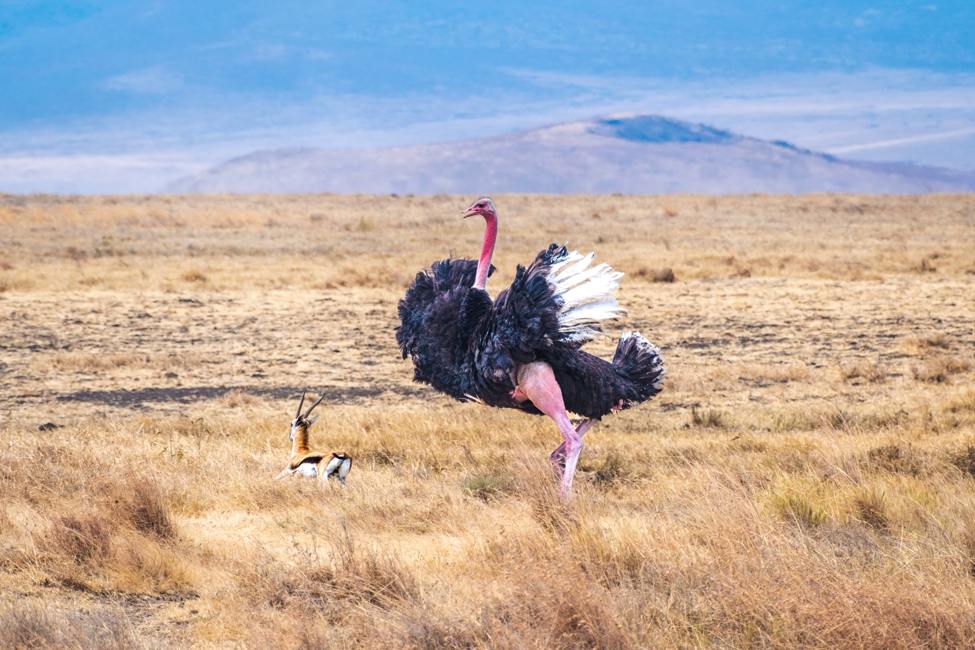
Their size makes ostriches are the easiest bird to spot in Ngorongoro Conservation Area, but there are many others to see as well. Photo by Audric Wonkam.
Birdwatching
The Cornell Lab of Ornithology has recorded more than 30 birding hotspots in the Ngorongoro Conservation Area, with the highest number of sightings in Ngorongoro Crater—a total of 631 species! Many of these birds gather around Lake Magadi, a saline lake at the bottom of the crater that fills every year with greater and lesser flamingos. Keep an eye out for ostriches, golden-winged and eastern double-collared sunbirds, stonechats, Jackson’s widowbird, hornbills, black-crowned night herons, pink-backed pelicans, black-chested snake eagles, and white-headed vultures.
Birdwatching in the Ngorongoro Conservation Area can be rewarding year-round, but the greatest diversity of species can be seen from November to May. During this time, migrant species arrive, and resident birds are more active due to increased food availability.

Olduvai Gorge in Ngorongoro Conservation Area is the site of many important fossil discoveries. Photo by Valetolo.
Learn about prehistory
The Olduvai Gorge, located near Ngorongoro Crater, is one of the world’s most important places for providing insights into human evolution. It has yielded some of the oldest evidence of human ancestors, including fossils of Homo habilis and Paranthropus boisei, as well as some of the earliest known stone tools made by humans.
Today, there is a small museum located at the site and lecture tours are given to visitors. The exhibits at the Olduvai Gorge Museum display artifacts and casts of hominid fossils from the surrounding area and explain the research around them. One exhibit is dedicated to fossilized footprints found 25 miles away at Laetoli, which also lies within the Ngorongoro Conservation Area. These footprints provide evidence that early hominids were already walking upright on two feet 3.6 million years ago.

A striking blue-green lake lies at the center of Empakaai Crater, here seen with Ol Doinyo volcano in the background. Photo by Daniel Msirikale.
Take a hike
Hikes aren’t permitted on the floor of Ngorongoro Crater, but there are plenty of opportunities for walking elsewhere in Ngorongoro Conservation Area. Go on a guided hike or walking safari along the crater rim or in the surrounding highlands to enjoy breathtaking views of the landscape and observe wildlife and plants in a more intimate setting. Walks are a great way to see some of East Africa‘s smaller animal attractions, like the Little Five.
Two of our favorite places to hike in Ngorongoro Conservation Area are Empakaai Crater and Olmoti Crater, two calderas that lie north of Ngorongoro Crater.
Empakaai Crater
At 300 meters deep and 4 miles wide, Empakaii Crater (also known as Empakai or Embagai) is much smaller than Ngorongoro Crater. But it’s worth a visit for its sapphire blue lake, which takes up about three-fourths of the crater floor. The views along the trail down are spectacular at every point. You might see Cape buffaloes or bushbucks, blue monkeys, and colorful birds like turacos. Waterbucks and elands frequent the lakeshore. The total hike is about 3 miles.
Olmoti Crater
Olmoti Crater is also 4 miles wide and home to stunning landscapes. The Munge River originates from the walls of Olmoti Crater, crosses the caldera and plummets down over cliffs, falling some hundreds of feet into the steep-sided ravine below. The crater floor is shallow and covered with tussocks of grass that feed elands, buffalos, and reedbucks. The trail here is about 2 miles.

Maasai beadwork is known for its colorful patterns and meticulous attention to detail. Photo by Denice Alex.
Discover a Different Culture
The Ngorongoro Conservation Area is home to several ethnic groups, including the Maasai, Hadza, Datoga, and Iraqw people. In recent years, their traditional ways of life have faced challenges due to factors such as land fragmentation, environmental degradation, and restrictions on hunting and grazing. Many communities are working to find sustainable solutions to these challenges while preserving their cultural heritage. One approach is to open their communities to offer cultural experiences to visitors.
Maasai
The Maasai are the most prominent ethnic group in the Ngorongoro Conservation Area, relying on its grasslands to sustain herds of cattle, sheep, and goats. Outsiders frequently recognize them by their colorful traditional clothing (shukas) and distinctive beadwork, although Western-style clothing is becoming more common.
Some Maasai villages welcome visitors to learn about their customs. Visitors are often fascinated by the Maasai warrior tradition, with young men undergoing rites of passage to become morans who protect their communities, livestock, and territory from external threats.
Hadzabe
About 1,200 Hadzabe live around Lake Eyasi on the southwestern edge of Ngorongoro Conservation Area. While their traditional and preferred lifestyle revolves around hunting and gathering, land encroachment means that they cannot meet all their needs this way.
Hadzabe hunters are often willing for visitors to observe their bow hunting and learn about the food and medicines that can be gathered from the wild. A few hours spent with the Hadzabe reveals an apparently inhospitable bush country as a veritable Eden. Learn about trees that provide a mosquito-repelling sap, plants used to heal cuts and snake bites, and how to get water in the dry season.
Datooga
Also concentrated near Lake Eyasi, the Datooga people are famous for their blacksmithing skills. Men do metal work over open fires, crafting arrowheads, spears, knives, and jewelry using just hot coals, bellows, and a few tools.
One thing that stands out to visitors are the beautiful circular patterns tattooed around the eyes and cheeks of many Datooga. You may also notice bronze and gold bracelets worn by Datooga women—these aren’t just for ornament, but double as musical instruments to accompany group singing.
Iraqw
The Iraqw people (known as Mbulu in Swahili) have a distinctive language that is more closely related to Ethiopian languages than other Tanzanian languages. Traditionally, they are farmers who cultivate crops such as maize, millet, sorghum, and beans and also practice animal husbandry.
The Iraqw are known for their underground rooms or homes dug into hillsides. Traditionally, these were built to help villagers face attacks by Maasai raiding parties. Today, round homes made of woven sticks and mud are the more common style, while some people build rectangular houses.
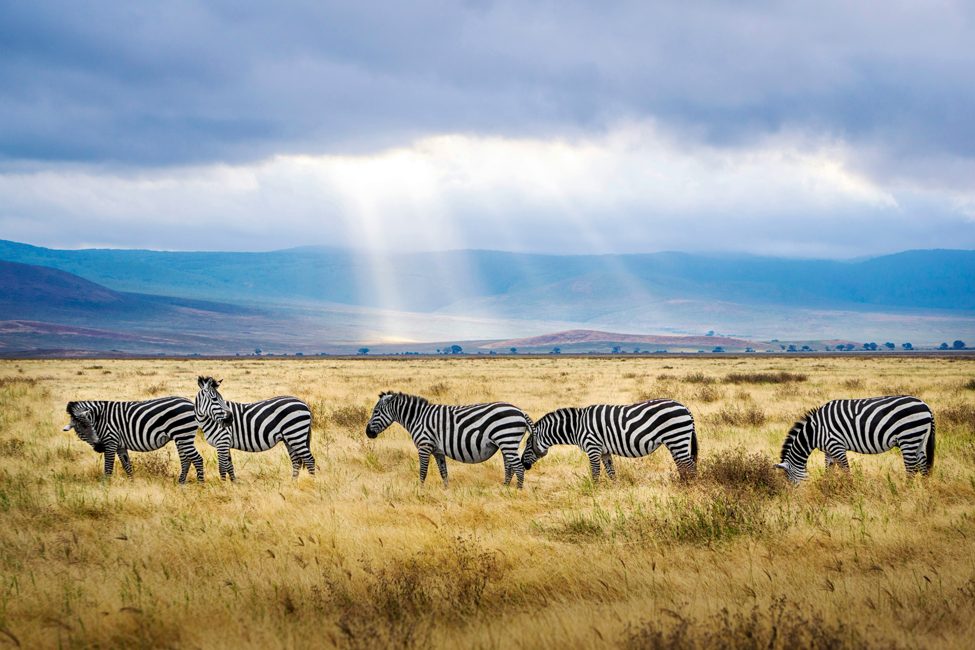
Zebras graze in Ngorongoro Crater. Photo by Hendrik Cornelissen.
Give it your best shot with a photographic safari
With its stunning landscapes and abundant wildlife, the Ngorongoro Conservation Area offers fantastic opportunities for photography enthusiasts. Specialized photography safaris are led by guides who are also expert photographers and give you access to special equipment, such as vehicles equipped with built- in camera stands.
On a photographic safari, your knowledgeable guide can help you capture intimate portraits of animals and their offspring, action shots of lions on the hunt, close-ups of plants or geological features, or wide-angle shots of vast zebra and wildebeest herds in the morning mist.
A photographic safari may also include stays at lodges that have wildlife hides, which allow you to get up-close photography of wildlife without alerting them to your presence.
Photography safaris can be customized to suit the interests and skill levels of participants. Whether you’re a beginner looking to learn the ins-and-outs of wildlife and landscape shots or an experienced photographer seeking unique opportunities for capturing rare species or behaviors, Ujuzi can tailor the itinerary to meet your needs. Our photographer guides can also help you decide which equipment to bring along, such as a DSLR or mirrorless camera, telephoto and wide-angle lenses, and plenty of memory cards and batteries.
With careful planning, skilled guides, and a bit of luck, you will return home with a portfolio of stunning photos to cherish for a lifetime.
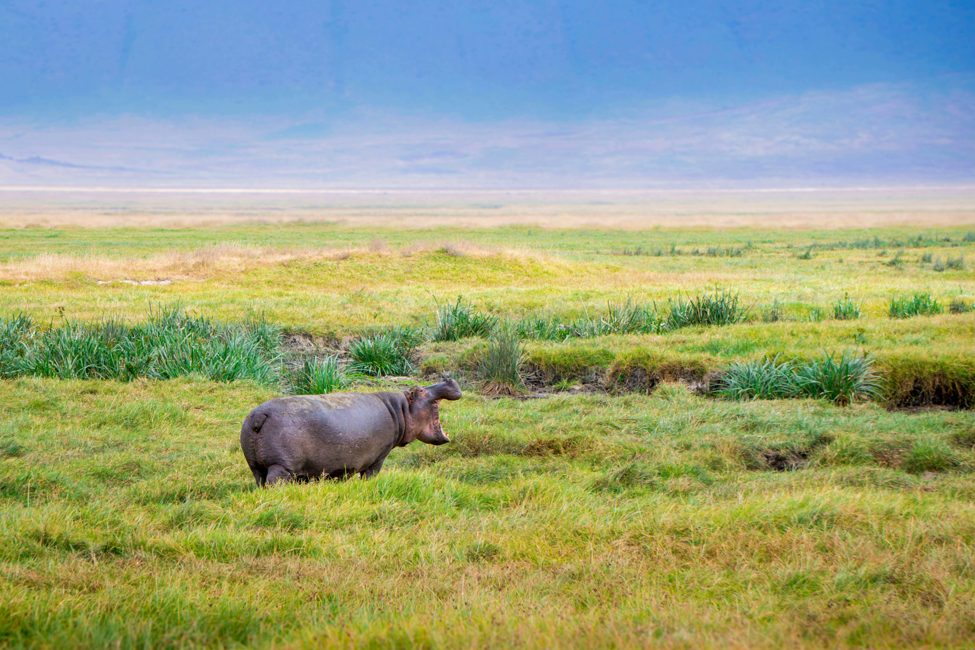
A hippo in Ngorongoro Conservation Area comes on land to eat. Photo by Hendrik Cornelissen.
Visiting Ngorongoro
Conservation initiatives within Ngorongoro Conservation Area have underscored the commitment of Tanzanians and the international community to preserve this awe-inspiring landscape for future generations. Tourism is an important source of income to support these conservation measures, from anti-poaching patrols to habitat restoration projects.
Our article touches on only some of the many possibilities for enjoying Ngorongoro Conservation Area. Other fun options include horse safaris in the highlands and hot air ballooning over the western plains to watch the Great Wildebeest Migration. As you traverse through this awe-inspiring terrain, you are not just witnessing nature’s grandeur, but also contributing to local conservation efforts and providing economic opportunities for surrounding communities.
Contact Ujuzi to plan your trip today!
Great Wildebeest Migration Map
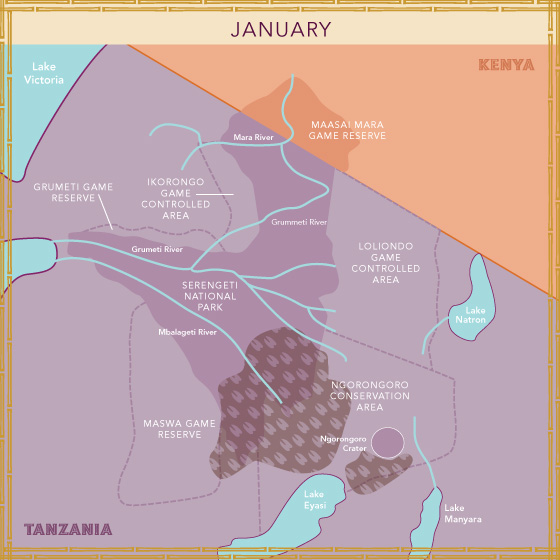
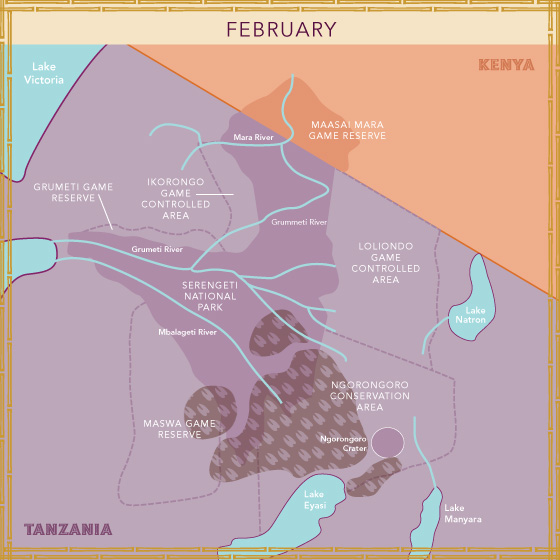
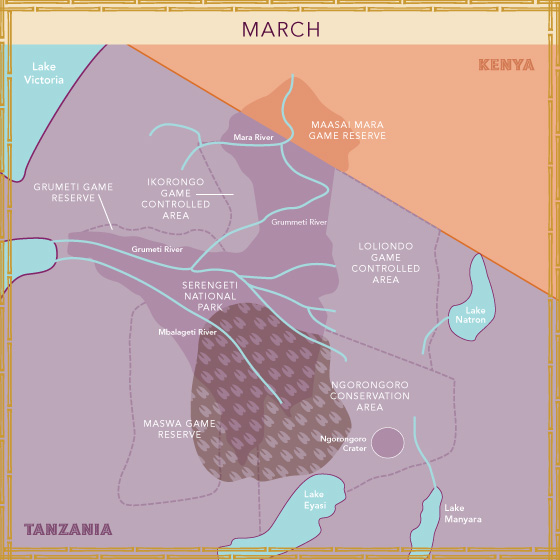
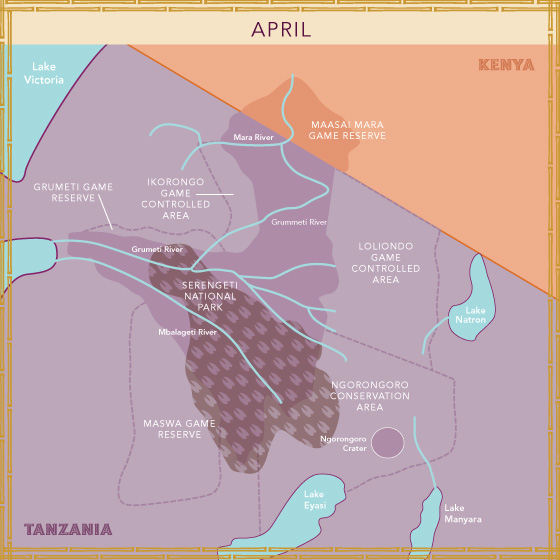
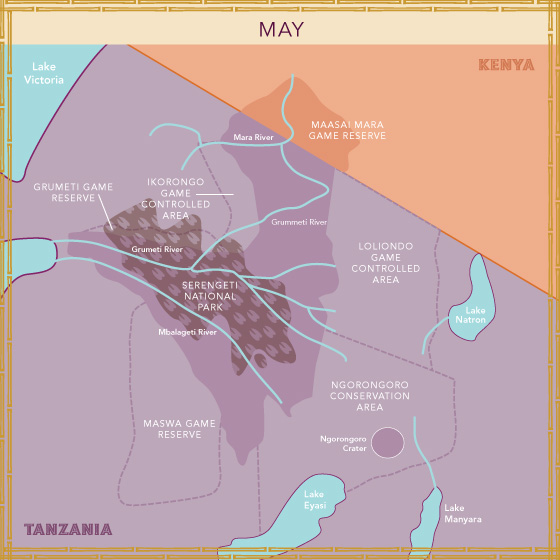
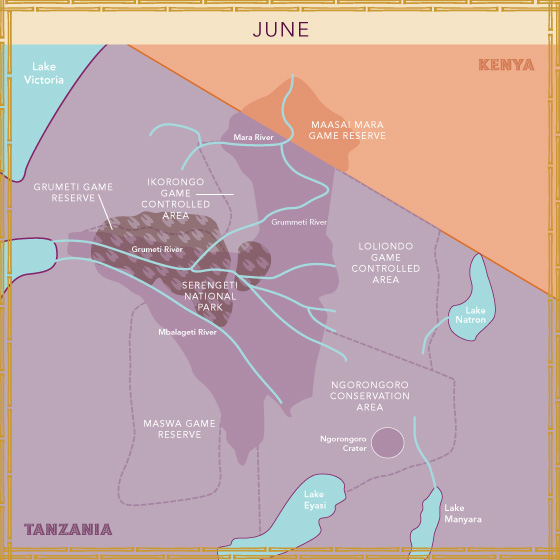
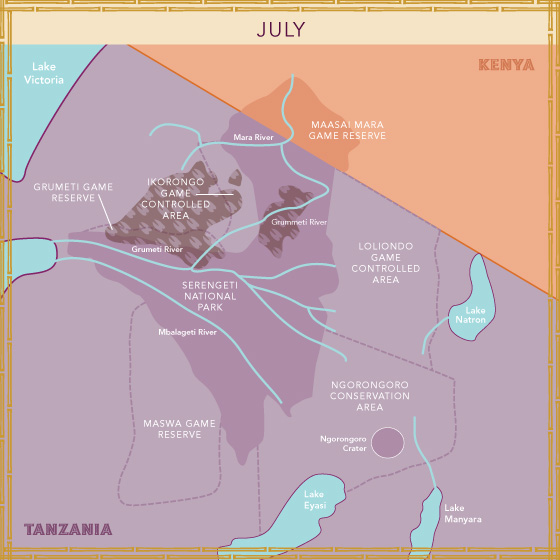
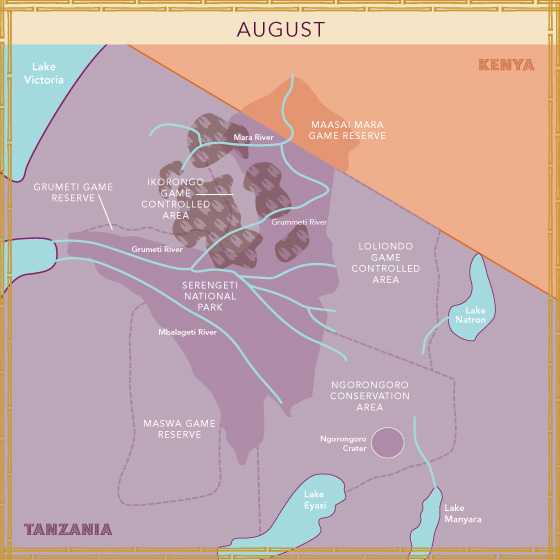
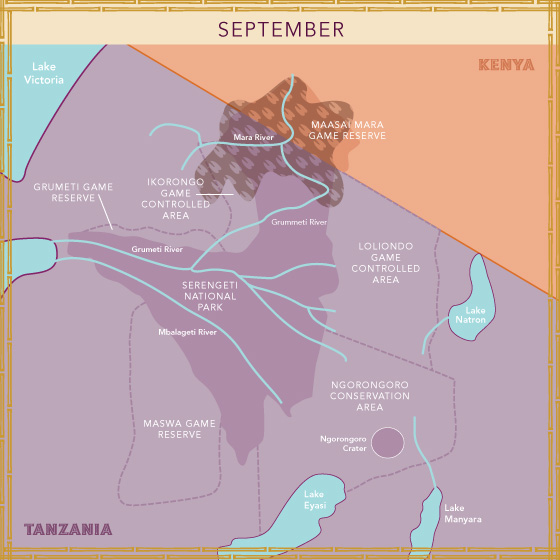
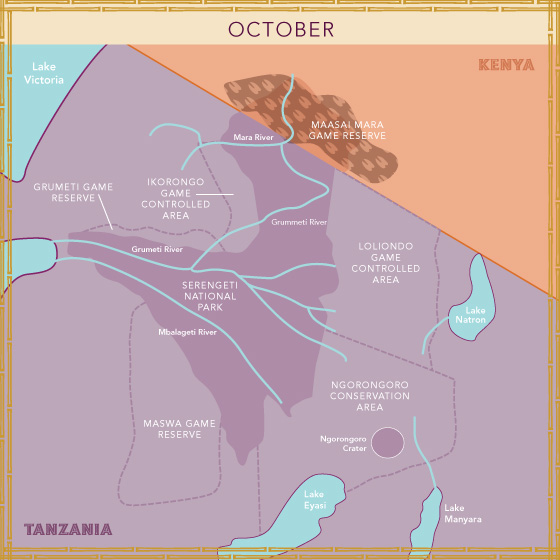
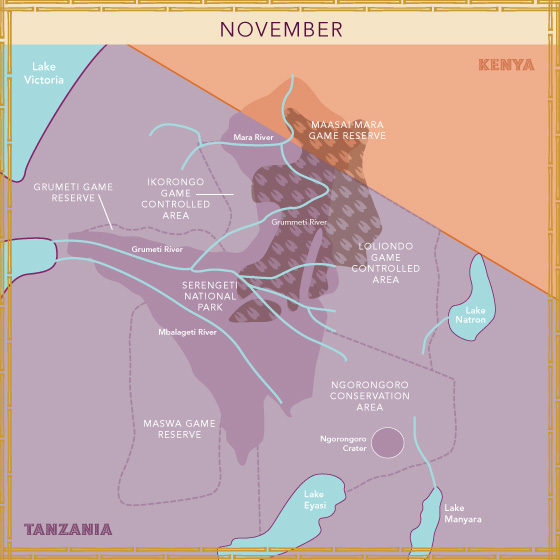
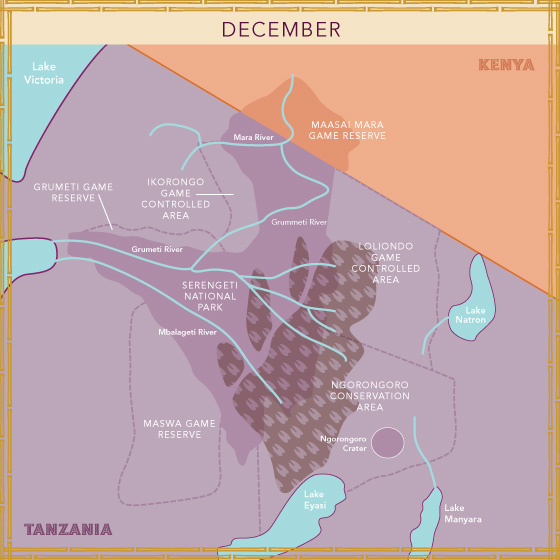
The largest and longest overland migration on earth, the Great Wildebeest Migration is a year-round trek taking two million wildebeest and countless zebras and antelope from the southern Serengeti to the Maasai Mara and back.
Select a month to forecast the wildebeests’ route, then contact us to schedule your Great Wildebeest Migration safari.
Sign up for the Ujuzi Newsletter!
From top travel tips to innovative safaris and conservation movement, get inspired to plan your next African safari!
By submitting this form, you are consenting to receive marketing emails from: . You can revoke your consent to receive emails at any time by using the SafeUnsubscribe® link, found at the bottom of every email. Emails are serviced by Constant Contact


